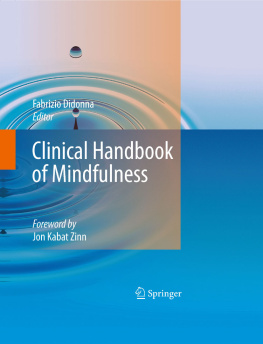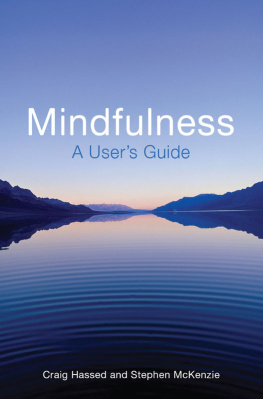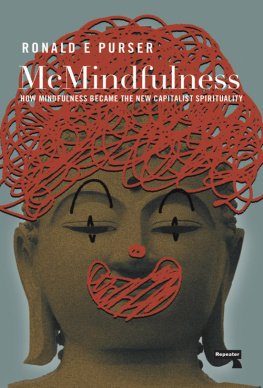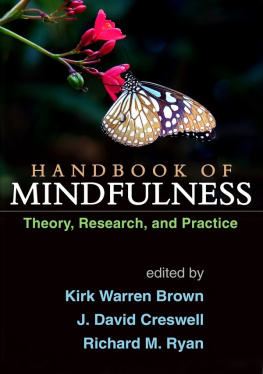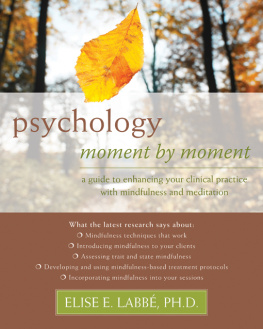Fabrizio Didonna (ed.) Clinical Handbook of Mindfulness 10.1007/978-0-387-09593-6_1 Springer Science+Business Media, LLC 2009
Over the last 2 decades there has been growing interest in the possible effectiveness of Eastern psychology in a clinical setting and in particular, those techniques based on practices of Buddhist origin. Numerous studies have attempted to investigate the possible clinical implications of these approaches and their application in the treatment of psychological disorders. In a spontaneous manner and through the independent work and studies of many researchers and therapists, this has given rise to a trans-epistemological approach, leading to experimentation and the application in clinical settings of principles and methods deeply rooted in Eastern psychology
All humanitys miseries derive from not being able to sit quietly in a room alone. Blaise Pascal, Seventeenth-century French philosopher
Over the last 2 decades there has been growing interest in the possible effectiveness of Eastern psychology in a clinical setting and in particular, those techniques based on practices of Buddhist origin. Numerous studies have attempted to investigate the possible clinical implications of these approaches and their application in the treatment of psychological disorders. In a spontaneous manner and through the independent work and studies of many researchers and therapists, this has given rise to a trans-epistemological approach, leading to experimentation and the application in clinical settings of principles and methods deeply rooted in Eastern psychology.
Interest in these approaches stems from an awareness that despite the importance of scientific methodology, which aims at ensuring rigorous procedure and seeks to further evidence-based knowledge, there appears to be a considerable need to combine these practices with the innate components of human nature that are decisive in influencing an individuals interpretation of events and his/her emotional attitudes and behavior. These components can be found in the acceptance of experience (Hahn, ) and in more general terms in a harmonizing and normalizing attitude toward intrapersonal and interpersonal variables.
All of these components can be summed up in the concept of mindfulness .
As is well explained in the first part of this book, mindfulness is the heart, or the core teaching, of Buddhist psychology (Kabat-Zinn, ).
A crucial aspect of most mindfulness practices is a sense of heightened but detached awareness of sensory and thought experience and, as Wolinsky ().
The ever-growing integration between mindfulness and psychotherapy is justified by the fact that mindfulness can be considered a trans-theoretical construct that has been used and integrated into different Western theoretical and therapeutic approaches that up to only two decades ago had few, if any, points of contact and dialogue. Today, different therapeutic models (cognitive-behavior therapy, constructivism, evolutionary psychology, humanist psychology, psychoanalysis, brain science, traumatology, positive psychology) now seem to have found a unifying factor and significant shared element that will make it possible, in the future, to better understand and develop the therapeutic factors common to all effective psychological treatments. Indeed, it can be argued that the mechanisms of change that form the basis of mindfulness meditation can be found in most Western psychotherapeutic perspectives.
Mindfulness-based approaches also pay particular attention to the importance of personal resources and potential and to the capacity of an individuals system to heal itself (or healing from within). By doing so, individuals spontaneously reach a point (especially when properly guided and oriented) at which they may pass from a state of imbalance and distress to a state of greater harmony and serenity with respect to themselves with a consequent enhanced subjective perception of well-being. Mindfulness practice (and all of the therapeutic possibilities that may stem from its use and application) is a discipline that unites all of the above healing components and provides a point of convergence in the fertile dialogue that has arisen over the last two decades between the East and West within the sphere of psychological science.
The Dialogue Between Western and Eastern Psychologies
Eastern meditative traditions and Western psychology have both aspects in common as well as significant differences. In order to better integrate the differing scientific approaches and methods of investigation, these similarities and differences must be fully understood. Western science has historically focused on the observer-independent physical world that can be studied objectively, using empirical facts and excluding subjective experience. Western psychology, and especially neuroscience, tends to view the mind from a mechanistic perspective, in which an often used metaphor is that of the mind as machine. From this perspective, it has been suggested that meditation works through such psychological mechanisms as relaxation, exposure, desensitization, dehypnosis, deautomatization, catharsis, and decounterconditioning (Murphy & Donovan, .
Buddhist tradition maintains that, in the words attributed to the Buddha, All phenomena are preceded by the mind. When the mind is comprehended, all phenomena are comprehended, and by bringing the mind under control, all things are brought under control (Santideva, 1961, p. 68, as cited in Wallace, . This perspective differs from that of Western modern science, which assumes that the mechanistic control of the environment, particularly the body and the brain, can alter ones sense of well-being, comfort, and distress.
Another important point is that Western culture tends to be monophasic, meaning that it is centered on, and conceptualized within, the usual waking state of consciousness, whereas the culture of meditative traditions (both Eastern and Western) is polyphasic and multistage, drawing on multiple states of consciousness and multiple adult developmental stages (Laughlin, McManus, & Shearer, .
According to Thurman (), scientists have more often than not considered reality to be something external to the world of human thought in as much as reality is part of the physical world. They have thought that the environment must be tamed, controlled, and modified in order to be adapted to human needs. In order to understand the outside world, Western science has without a doubt made extraordinary efforts and achieved excellent results. Examples of this are the use of chemistry, pharmacology, and surgery to cure illness, both physical and psychological. However, Western science has focused solely on the study of potential cures outside the self, introducing them into ourselves via highly advanced technologies. And yet by doing so, it has given less importance to the positive and therapeutic potential that each one of us has within ourselves. Buddhist tradition, on the contrary, focuses on the importance of internal science and considers the science of the mind to be the most important to the internal sciences, the king of all sciences. These beliefs have developed, thanks to the intense and antique tradition based on the practice of meditation.
Another important difference between the two psychologies lies in the methods and the means for obtaining mental health. Both systems of belief have their own theories, but there is room for fruitful and effective collaboration between the two. Western psychotherapy tends to focus mainly on the content of the consciousness and does not try to achieve the more radical transformation proposed by Buddhist psychology, which focuses on the process of the consciousness. The aim is to free individuals from negative mental states by altering the perceptive and cognitive processes.

